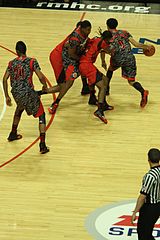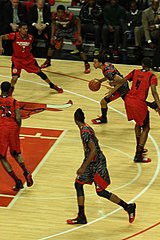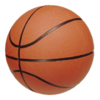| Revision as of 18:57, 26 April 2016 edit38.104.134.62 (talk) Biased explanation. Warrior hater.Tags: Mobile edit Mobile web edit← Previous edit |
Latest revision as of 22:14, 5 November 2024 edit undoPol098 (talk | contribs)Extended confirmed users, Pending changes reviewers118,919 edits {{Refimprove|date=November 2024}} |
| (26 intermediate revisions by 20 users not shown) |
| Line 1: |
Line 1: |
|
|
{{Short description|Blocking move in team sports}} |
| ⚫ |
{{See also|Screen pass}} |
|
|
|
|
|
|
|
{{Refimprove|date=November 2024}} |
|
{{multiple image |
|
{{multiple image |
|
| align = right |
|
| align = right |
| Line 24: |
Line 25: |
|
| header_align = <!-- left/right/center --> |
|
| header_align = <!-- left/right/center --> |
|
| header_background = |
|
| header_background = |
|
| footer = After ] sets a pick on ] for ], that breaks Williams-Goss free for a drive down the lane at the ] |
|
| footer = After ] sets a pick on ] for ], that breaks Williams-Goss free for a drive down the lane at the ] |
|
| footer_align = <!-- left/right/center --> |
|
| footer_align = <!-- left/right/center --> |
|
| footer_background = |
|
| footer_background = |
|
| background color = |
|
| background color = |
|
}} |
|
}} |
| ⚫ |
Screens can be on-ball (when set for the ball-handler), or off-ball (when set for a teammate moving without the ball to get open for a pass). The two offensive players involved in setting the screen are known as the ''screener'' (who blocks the defender) and the ''cutter'' (who gets free from the defender). |
|
|
|
|
|
|
⚫ |
A '''screen''' in ]s is a blocking move by an offensive player in which they stand beside or behind a defender in order to free up a teammate to shoot, pass, or drive the ball in to score. In ] and ], it is also known as a ''']'''. Screens can be on-ball (when set for the ball-handler), or off-ball (when set for a teammate moving without the ball to get open for a pass). The two offensive players involved in setting the screen are known as the ''screener'' (who blocks the defender) and the ''cutter'' (who gets free from the defender). |
| ⚫ |
Successfully "setting a screen" in ] such as ] and ] requires attention to position and timing. An offensive player will first establish position so that his teammate can move toward him. The teammate changes pace and direction, and ''cuts'' (moves or dribbles quickly) very close to the screening player. The defender who is covering the cutter will have to push into the screening player, or divert around, losing a few steps. In basketball, the offensive player setting the pick must remain stationary at the moment of contact with the defender, and allow the defensive player a "reasonable opportunity" to avoid the screen; a screen is illegal if the screener moves in order to make contact, and obtains an advantage; the result is an offensive foul. There must be illegal contact for a moving screen to be a foul; no illegal contact, no foul, no matter how much moving the screener does. If the screener holds, leans or moves into the defender to cause contact, this will result in a foul on the screener. |
|
|
|
|
|
|
⚫ |
Successfully "setting a screen" in ] such as ] and ] requires attention to position and timing. An offensive player will first establish position so that a teammate can move toward them. The teammate changes pace and direction, and ''cuts'' (moves or dribbles quickly) very close to the screening player. The defender who is covering the cutter will have to push into the screening player, or divert around, losing a few steps. In basketball and lacrosse, the offensive player setting the pick must remain stationary at the moment of contact with the defender, and allow the defensive player a "reasonable opportunity" to avoid the screen; a screen is illegal if the screener moves in order to make contact, and obtains an advantage; the result is an offensive foul in basketball and a ] in lacrosse. There must be illegal contact for a moving screen to be a foul; no illegal contact, no foul, no matter how much moving the screener does. If the screener holds, leans or moves into the defender to cause contact, this will result in a foul on the screener. |
| ⚫ |
] and ] for Chris Walker at the ].]] |
|
|
|
|
|
⚫ |
] and ] for Chris Walker at the ].]] |
|
|
|
|
|
After setting the screen, the screener is often open to roll to the basket and receive a pass. This tactic is called ] in basketball. Another basketball tactic, called the ], is for the ballhandler to drive to the basket while the screener squares for a jumpshot. |
|
After setting the screen, the screener is often open to roll to the basket and receive a pass. This tactic is called ] in basketball. Another basketball tactic, called the ], is for the ballhandler to drive to the basket while the screener squares for a jumpshot. |
| Line 39: |
Line 41: |
|
Defensive moves to defeat a screen include sliding by the pick if the screening player leaves space, fighting over the screen (pushing the screener away, where allowed—this is not allowed in basketball), if the defender is strong enough, or switching defensive assignments with another defender, who can pick up the cutter on the other side of the screen. |
|
Defensive moves to defeat a screen include sliding by the pick if the screening player leaves space, fighting over the screen (pushing the screener away, where allowed—this is not allowed in basketball), if the defender is strong enough, or switching defensive assignments with another defender, who can pick up the cutter on the other side of the screen. |
|
|
|
|
|
In the team sport ] setting a screen is not allowed.<ref>{{cite web|title=WFDF Rules of Ultimate 2013|url=http://www.wfdf.org/about/meeting-minutes/doc_download/20-rules-of-ultimate|publisher=World Flying Disc Federation|accessdate=9 November 2014}}</ref> The screened player can call "pick", whereupon the play stops with all other players holding their current positions. The screened player can now catch up to the offensive player he or she was defending, then play continues. |
|
In the team sport ] setting a screen is not allowed.<ref>{{cite web|title=WFDF Rules of Ultimate 2013|url=http://www.wfdf.org/about/meeting-minutes/doc_download/20-rules-of-ultimate|publisher=World Flying Disc Federation|access-date=9 November 2014}}</ref> The screened player can call "pick", whereupon the play stops with all other players holding their current positions. The screened player returns to defend the offensive player he or she was defending and then play continues. |
|
|
|
|
|
== See also == |
|
== See also == |
|
⚫ |
* ] |
|
|
* ] |
|
* ] |
|
* ] |
|
* ] |
|
* ] |
|
* ] |
|
* ] |
|
|
|
|
|
== References == |
|
== References == |
| Line 56: |
Line 60: |
|
] |
|
] |
|
] |
|
] |
|
|
] |
After setting the screen, the screener is often open to roll to the basket and receive a pass. This tactic is called pick and roll in basketball. Another basketball tactic, called the pick and pop, is for the ballhandler to drive to the basket while the screener squares for a jumpshot.
Defensive moves to defeat a screen include sliding by the pick if the screening player leaves space, fighting over the screen (pushing the screener away, where allowed—this is not allowed in basketball), if the defender is strong enough, or switching defensive assignments with another defender, who can pick up the cutter on the other side of the screen.


 After Jarell Martin sets a pick on Cat Barber for Nigel Williams-Goss, that breaks Williams-Goss free for a drive down the lane at the 2013 McDonald's All-American Boys Game
After Jarell Martin sets a pick on Cat Barber for Nigel Williams-Goss, that breaks Williams-Goss free for a drive down the lane at the 2013 McDonald's All-American Boys Game

